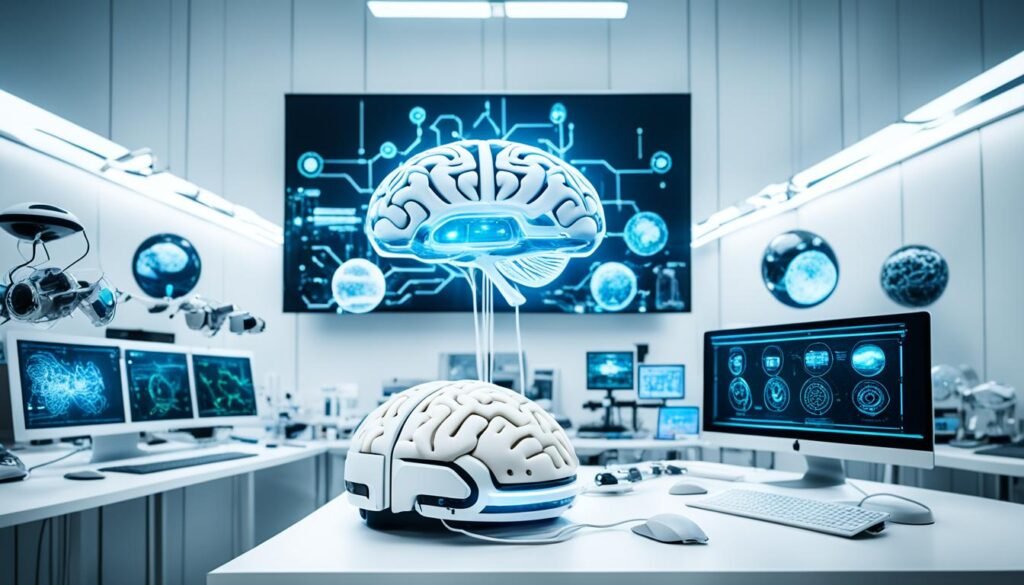The study of neuroethics is becoming more important as we learn more about the brain. Books like “The Battle for Your Brain” by Nita A. Farahany in 2023 highlight the need for ethical thinking in brain science1. Another book, “Brain Science for Lawyers, Judges, and Policymakers” by Owen D. Jones, Jeffrey D. Schall, Francis X. Shen, Morris B. Hoffman, and Anthony D. Wagner, is coming out in 2024. It will focus on the ethics of brain science advancements1.
Neuroethics looks at the ethical sides of brain science and its uses2. As we move forward with new brain technologies, we need to think carefully about their impact. Neuroethics helps us make choices that respect our values and ethics.
Neuroethics covers many topics, like the good and bad sides of brain boosters and how some people might not get to use them2. As we go deeper into brain tech, we face big questions. These include who we are, what makes us real, and what being human means with neurotechnology.
Key Takeaways
- Neuroethics is a key area that looks at the right and wrong of brain science and brain boosters.
- More research and use of brain science shows we need to think about ethics more.
- Neuroethics deals with many issues, like the good and bad of brain boosters and unequal access to them.
- Looking into brain tech makes us wonder about our identity, being real, and what it means to be human now.
- Deciding wisely with brain tech needs a strong moral guide based on neuroethics.
Understanding the Landscape of Neuroethics
Neuroethics is a complex field that connects neuroscience with ethics. It’s a bridge between new brain science discoveries and the ethical questions they raise. This field looks at ethical, social, and legal issues linked to brain science and new brain technologies3.
Defining Neuroethics and Its Scope
Neuroethics focuses on the ethics of brain science research and its uses. It covers many topics, like the right and wrong of using brain tech to improve thinking. The BRAIN Initiative started in 2013 to boost brain science with new tools and tech4. It made sure ethics was a key part of the project4.
The Intersection of Neuroscience, Ethics, and Society
Neuroethics links brain science, ethics, and society. It makes sure new discoveries are made responsibly. It looks at the values behind brain research and how they match with society’s values3.
Working together, neuroscientists and neuroethicists are key to ethical brain science. The level of ethics involvement depends on the research type4. The Neuroethics Roadmap calls for more support for these collaborations4.
Neuroethics is a critical field that helps us navigate the complex moral landscape of neuroscience and its applications, ensuring that we advance scientific knowledge while upholding the highest ethical standards.
Efforts to engage the public in neuroethics aim to improve understanding and share info through research, media, and events3. Good public engagement means talking to all stakeholders and disciplines for mutual learning3. Addressing ethical issues in brain science is key to gaining trust, moving forward, and getting funding3.
As we delve deeper into the human brain and create new brain technologies, we must do so ethically. Neuroethics guides us with its principles and tools. This ensures our quest for knowledge and innovation respects moral values and societal norms.
Historical Context and Modern Developments in Neuroethics

The study of neuroethics has grown over time, influenced by history and new discoveries in neuroscience. In the mid-20th century, neuroscience made big leaps that brought up ethical questions5. One key event was the discovery of prefrontal lobotomy in the 1930s as a mental illness treatment. This showed the ethical sides of using neuroscience, because of its bad effects5.
By the 1990s, neuroscience made more progress, especially in neuroimaging with techniques like fMRI and PET. These advances led to worries about privacy and how neuroimaging data could be misused5. Ethicists are still figuring out how to handle unexpected findings from brain scans, but no clear rules exist6.
The Evolution of Neuroethics as a Field
Neuroethics is now a field that combines neuroscience, philosophy, law, psychology, and bioethics to tackle the ethical issues of neuroscience research5. It’s a new field that helps shape how people see and understand neuroscience by linking science with ethics5.
Neuroethics helps guide research and policy by looking at the good and bad sides of neuroscience discoveries5. It’s taken seriously in places like the National Institutes of Health (NIH), where it’s seen as a positive thing7. But, some critics have slowed down plans like the NIH BRAIN Initiative’s second half7.
Key Milestones and Breakthroughs in Neuroscience
Recent advances in neuroethics come from big steps forward in neuroscience. Brain-computer interfaces (BCIs) let people control tech with their brains, raising questions about privacy and control5. Cognitive enhancement technologies are also being explored, bringing up ethical issues about fairness, access, and risks of improving brain functions5.
Neuroscience touches many areas, not just medicine, like marketing, justice, the military, and work productivity6. It challenges our old beliefs about right and wrong, and our views on spirituality6. As neuroscience keeps moving forward, neuroethics is key in navigating these ethical issues.
Cognitive Enhancement: Promises and Perils
Many people are looking into ways to boost their brain power. This field includes substances and tech that aim to make us smarter, more focused, and better learners. It’s important to look at both the good and bad sides of these options.
Defining Cognitive Enhancement and Its Applications
The cognitive enhancement definition is about making our brains work better than usual. This can be done with drugs or brain stimulation. People use it for school, work, or just to feel better.
Neuroethics helps us talk about these brain-boosting technologies. It uses science to guide us. We need to think about how society sees these issues8. Understanding how the brain works helps us talk about these topics better8.
Potential Benefits and Risks of Cognitive Enhancement
Using brain boosters could make us do better in school, work, and make smarter choices. It could also help people with brain problems live better lives.
But, there are risks too. We don’t know for sure if these boosters are safe long-term. They could have bad side effects. Also, using them too much could make things unfair in society.
| Journal | Publications | Percentage |
|---|---|---|
| Frontiers in Systems Neuroscience | 3 | 5.77% |
| AJOB Neuroscience | 3 | 5.77% |
| Neuroethics | 2 | 3.85% |
Studies show more people are interested in neuroethics and brain boosters. Journals like Frontiers in Systems Neuroscience and Neuroethics are leading the discussion9. They help us understand the ethical sides of brain enhancement9.
When looking at brain boosters, we need to study how they work in real life8. By knowing more about the brain, we can make better rules for these technologies8.
Ethical Considerations in Cognitive Enhancement

Exploring cognitive enhancement brings up big ethical questions. More people, including healthy ones, are using drugs and brain stimulation to boost their brain power for work. This raises big concerns10. These technologies could make our brains work better but also come with risks we need to think about carefully10.
One big ethical issue is fairness. With 34% of college students using drugs to help them study, it’s clear there’s a big gap in who can get these enhancements11. This could make things worse for those who can’t afford these tools, making things more unfair10.
“The pursuit of cognitive enhancement raises a multitude of ethical considerations that must be carefully examined, including questions of fairness, equity, safety, and the right to control one’s own cognitive processes.” – Dr. Emily Thompson, Neuroethicist
Another big debate is about cognitive liberty. It’s about if we should be able to decide how to improve our brains. Some say it’s our choice, but others worry it could make us less real or force us in places like school or work10.
It’s also important to think about the safety of these brain-boosting technologies. Even though they seem safe, we don’t know much about their long-term effects11. With more people using them without proper training, it’s a big health risk11.
Looking at history helps us understand the risks of cognitive enhancement. People have always tried to boost their brains with things like tonics and drugs10. But, we’ve seen problems before, like with cocaine and amphetamines, which led to laws10. We need to learn from this to make sure we’re safe and careful now10.
| Ethical Consideration | Key Points |
|---|---|
| Fairness and Equity | – Access to cognitive enhancement technologies may exacerbate social inequalities – Potential for unfair advantages in competitive environments |
| Cognitive Liberty | – Right to control one’s own cognitive processes – Balancing personal choice with concerns about authenticity and coercion |
| Safety and Regulation | – Need for thorough investigation of long-term effects – Importance of informed regulation to protect public health |
| Historical Context | – Learning from past instances of drug abuse and misuse – Developing stricter regulatory procedures based on historical lessons |
Dealing with cognitive enhancement ethics needs open talks among many groups. We must think about what’s right for everyone involved. By looking at the big picture and focusing on what’s best for us, we can make sure these technologies are used right and fairly.
Neuroethics and the Debate on Fairness and Equity
The field of neuroethics is growing, bringing up big questions about fairness and equity in brain boosters. These technologies could make things worse for those already behind, creating a big gap in society.
Brain boosters start big talks on fairness and making sure everyone gets the same chance. They worry about who gets these technologies and who gets left out. This is a big issue for leaders, experts, and us all.
Access to Cognitive Enhancement Technologies
One big worry is that not everyone can get brain boosters. As they get better and more common, only the rich might get them. This could make the gap between rich and poor even bigger.
Dr. Veljko Dubljević, a top neuroethics researcher, talks a lot about the right and wrong of brain boosters12. He says we need to make sure everyone can get these technologies. We also need to stop the bad effects of some people having more advantages.
Socioeconomic Disparities and the Enhancement Divide
Brain boosters could make the gap between rich and poor even wider. The rich will likely get these technologies first, giving them a big edge in school, work, and life.
“The enhancement divide is not just a matter of fairness; it is a matter of social justice. We must work to ensure that the benefits of cognitive enhancement are distributed equitably and that no one is left behind.” – Dr. Veljko Dubljević
We need leaders and experts to work together on this. They should make sure brain boosters are fair for everyone. This could mean making them affordable for all, setting rules against misuse, and teaching people about the choices they have.
- Ensuring affordable access to cognitive enhancement technologies for all individuals, regardless of socioeconomic status
- Implementing regulations to prevent the abuse or misuse of these technologies
- Investing in public education and outreach to promote informed decision-making about cognitive enhancement
| Potential Benefits | Potential Risks |
|---|---|
| Improved cognitive function | Exacerbation of existing inequalities |
| Enhanced productivity and efficiency | Unequal access based on socioeconomic status |
| Increased quality of life | Potential for abuse or misuse |
As we look into the future of brain boosters, we must focus on fairness and making sure everyone gets a fair shot. By tackling the risks and making sure everyone can use these technologies, we can make them good for everyone.
Neuroenhancement and Personal Identity

The debate over neuroethics brings up big questions about who we are and how we see ourselves. Using brain technologies to get better has made us think deeply about our identity. It’s made us wonder about the real us and what happens if we change our brains.
The Impact of Cognitive Enhancement on Sense of Self
Technologies like deep brain stimulation can change how we see ourselves. Studies show that about 25% of research focuses on how these technologies affect our identity13. This shows we’re really interested in how these changes might shape our understanding of ourselves.
Our stories about ourselves, or narrative identity, are key in this debate. Many studies talk about how these stories and our moral values are linked to our identity13. This shows how important these ideas are in the ethics of brain technologies.
Authenticity and the Pursuit of Self-Improvement
Wants to get better through brain tech make us question what being real means. Many studies talk about staying true to ourselves with these technologies13. This shows it’s a big worry in the ethics of brain tech.
Some think these technologies could make us less ourselves by changing our brains. Others believe wanting to get better is natural and that these technologies help us grow and be fulfilled.
| Concept | Frequency in Neuroethics Literature |
|---|---|
| Deep Brain Stimulation and Personal Identity | 25% of articles |
| Narrative Identity and Moral Identity | High occurrence rate |
| Authenticity and Cognitive Enhancement | Frequent references |
There’s a big debate on whether brain tech helps or hurts our identity. Some articles focus on our right to choose, while others talk about the risks13. This shows we’re not sure if these technologies are good or bad for us.
The question of whether neuroenhancement technologies threaten or support personal identity remains a complex and multifaceted issue that requires ongoing exploration and dialogue.
As we think about brain tech, we need to look at how it changes us and our goals for self-improvement. Talking across different fields and listening to many views helps us understand how brain tech and identity are linked.
Privacy and Autonomy in the Age of Neurotechnology
Neurotechnology is getting more advanced, making it key to protect our brain privacy and freedom. Keeping our brain data safe is vital to stop misuse and let us control our thoughts14. A study in 2022 by Shannon Brenda Bothof looked into how Brain-Computer-Interfaces (BCIs) change society. It showed why we need to talk about neurorights and technology15.
Our mental integrity means we can think and decide on our own, without outside control from tech14. It’s about protecting our thoughts and feelings that make us who we are14. Keeping our minds private is key to this, keeping others from invading our thoughts14.
Privacy of the mind is the condition where every mental event or subjective experience is free from external intrusion14.
Neuroethics is all about protecting our freedom to think and control our minds. It looks at things like our intentions, our own view of the world, and our sense of self14. Being able to make our own choices depends on keeping our minds our own14.
- Intentionality is a key ability that lets us focus our thoughts on things14.
- Humans have a special kind of intentionality that sets us apart from other beings and machines14.
As BCIs get better, we need to think about how they affect our privacy and brain data15. We must make sure these technologies respect our privacy and freedom. This means we keep control over our thoughts and feelings.
We need strong rules and ethical standards to stop the misuse of brain data. This way, we can enjoy the good parts of these technologies without losing our privacy or freedom. By talking and making informed choices, we can handle the complex issues of neuroethics well.
Regulating Cognitive Enhancement: Policy and Governance

Neurotechnology is moving fast, making it crucial to have strong rules and guidelines. It’s hard to balance innovation, safety, and ethics in cognitive enhancement tech16. With new methods like deep brain stimulation and brain-computer interfaces, we need to act fast to set rules16.
Existing Frameworks and Guidelines for Neuroethics
Groups have made rules for handling new neurotech challenges. The OECD has guidelines for making and using neurotech responsibly. They talk about being open, taking responsibility, and involving the public in decisions on cognitive enhancement.
“The discourse on cognitive enhancement allows democratic societies to prepare for the challenges and opportunities presented by these technologies, even though their social implications remain largely speculative at this stage.”17
Other efforts to set rules include:
- The Neuroethics Guiding Principles for the NIH BRAIN Initiative
- The IEEE Brain Initiative Neuroethics Framework
- The European Union’s Human Brain Project Ethics and Society Program
Challenges in Regulating Rapidly Evolving Technologies
Even with rules, it’s tough to keep up with fast-changing tech18. New methods and uses mean regulators must always update their policies. They need to support innovation and keep people safe.
| Challenge | Description |
|---|---|
| Defining Cognitive Enhancement | There’s no clear, agreed-upon definition of cognitive enhancement, making it hard to set rules. |
| International Coordination | Different cultures and laws around the world make it hard to have the same rules everywhere. |
| Balancing Innovation and Safety | Regulators must find a balance between advancing science and keeping people safe and healthy. |
To overcome these hurdles, we need ongoing talks and teamwork among policymakers, researchers, and others. By planning ahead and being adaptable, we can handle the good and bad sides of cognitive enhancement tech17. This way, we make sure these technologies fit our values and help society as a whole.
Public Engagement and Dialogue on Neuroethics
Neuroethics is growing fast, making it key to involve the public in discussions and decisions. We aim to make people understand the ethical and legal sides of neuroscience research and its uses, especially in brain-boosting tech19. By talking between scientists, lawmakers, and everyone else, we can make sure these new technologies fit with what society values.
Fostering Informed Debate and Decision-Making
Getting people involved in neuroethics needs a mix of strategies and tools. At the Arizona Science Center, 130 visitors learned to work better together, like sharing ideas and understanding others20. This shows how important it is to make learning fun and thought-provoking, making people think deeply about brain science ethics.
To help people make informed choices, we need easy-to-use resources and learning materials. Over 95% of people found our activities interesting20. This shows we can grab people’s attention and get them to think about brain science and ethics. Giving clear, balanced info helps people make their own views, adding to the ongoing debate on brain-boosting tech.
The Role of Media and Science Communication
The media shapes how people see neuroethics. It’s key to make brain science easy to understand and interesting for everyone. People at the AAAS meeting wanted to learn from each other and talk more20. This shows how important it is for scientists, media, and the public to work together to talk about brain ethics.
To make media and science communication better, we need plans that meet the needs of different groups. Ideas to use public engagement tools with more people, like lawmakers and tech leaders20, show we’re recognizing the need for many views in neuroethics.
Neuroethics is about letting people like scientists, doctors, patients, and the public talk about brain science’s ethical and legal sides19.
As we move forward in brain science and brain-boosting tech, we must make sure people and scientists talk more equally. Projects like the Neuroscience & Society Center plans by the Dana Foundation offer chances for ongoing talks and learning with brain experts20. This helps us make decisions on brain-boosting tech with everyone’s input, making it more inclusive.
The Future of Neuroethics and Cognitive Enhancement

We are on the edge of a new era in neuroscience and cognitive enhancement. Neuroethics is at a key point. The fast growth of neurotechnologies is changing how we see the brain and could improve our thinking. But, these new possibilities bring big ethical questions.
Neuroethics must tackle the complex moral issues of cognitive enhancement. The BRAIN Initiative started in 2013 aims to improve our understanding of the brain with new tools and technologies. Now, we need ethical advice more than ever21. It’s important to mix neuroscience with neuroethics to make sure we use these new things right, thinking about how they affect society21.
To reach our goals, we need neuroethicists and neuroscience teams to work together. The BRAIN Initiative Neuroethics Subgroup (BNS) has set out key areas to focus on. These include making sure neuroethics and neuroscience work together, providing tools to spot ethical issues, and making guidelines for data and new applications21. With support for these efforts, we can make sure ethics is part of neuroscience from the start.
The future of making our brains better is exciting but also hard to predict. As we learn more about the brain and make new technologies, we must watch out for risks. We need to make sure we’re making things better for everyone, not just some, and keeping our dignity.
The challenge before us is to harness the transformative potential of cognitive enhancement while navigating the ethical complexities that arise from manipulating the very essence of who we are.
To overcome this challenge, we need to talk and work together across different fields. We should bring together experts in neuroscience, ethics, law, policy, and public engagement. This way, we can make sure cognitive enhancement is done right for everyone.
The future of neuroethics and cognitive enhancement is full of chances and big responsibilities. As we move into a new era of brain science, let’s be wise, kind, and committed to ethics. By working together, we can make sure the power of our minds is used for good, not just more thinking but also for being morally right and acting ethically.
Case Studies and Real-World Examples

Looking into neuroethics and cognitive enhancement tech, we must focus on real cases. These examples show us the tough choices and best ways to handle them. By looking at specific situations, we learn a lot about how to apply neuroethical rules in real life. This helps us make better choices in the future.
Examining Specific Scenarios and Dilemmas
One big case in neuroethics is about “smart drugs” for students. A survey found 40% of students wanted to use these drugs to do better in school22. This brings up big questions about fairness and the pressure to use these drugs to keep up.
In sports, another big issue is athletes using drugs to get ahead. Research showed 30% of athletes might use drugs for a competitive edge22. This shows we need clear rules about using these technologies in sports to keep things fair.
There’s also worry about using neuroscience for bad things, like making dangerous substances. A study found 15% of people knew about this risk22. This highlights the need for careful research and strong rules to prevent misuse.
Lessons Learned and Best Practices
Looking at real cases teaches us a lot about handling the tricky parts of cognitive enhancement tech. One big lesson is the importance of talking and working together. This includes neuroscientists, ethicists, lawmakers, and the public. The Neuroethics Society started by experts shows how working together can help.
Good practices in neuroethics mean being open, getting consent, and protecting people’s rights. For example, some people worry about brain scans that can tell if someone is lying or if they’re sane22. To deal with these worries, we need strong ethical rules and guidelines that protect everyone’s rights and well-being.
| Neuroethical Dilemma | Key Considerations | Best Practices |
|---|---|---|
| Use of “smart drugs” in academia | Fairness, equity, pressure to compete | Clear guidelines, education, support services |
| Cognitive enhancement in athletics | Level playing field, health risks | Regulations, testing, athlete welfare |
| Misuse of neuroscience for harm | Responsible conduct, oversight | Ethical review, security measures, international cooperation |
By looking at real cases in neuroethics, we see patterns, challenges, and ways to tackle the tough parts of cognitive enhancement tech. Through talking, researching, and making strong ethical rules, we can make sure these technologies are good for everyone. We can keep their risks low and respect important ethical values.
Interdisciplinary Approaches to Neuroethics

Neuroethics is a field that needs experts from many areas to work together. It deals with the ethics of brain technologies and neuroscience. Since 2002, neuroethics has been seen in two ways: as a practical ethics and as a study of the issues neuroscience raises23. Experts from neuroscience, philosophy, law, psychology, and bioethics are all part of this team.
Working together across disciplines is key to understanding the ethics of brain technologies. A newer approach, fundamental neuroethics, focuses on deep analysis of big ideas like consciousness and identity23. It aims to connect neuroscientific and philosophical ideas, making sure ethics is based on solid knowledge from many fields23.
Collaboration Across Fields and Disciplines
Working together is crucial for making progress in neuroethics. Neuroscience looks at the brain from the outside, but it might miss the inner experiences of being conscious or aware of oneself23. Neurophenomenology combines outside views with personal experiences to understand our inner lives better23.
Neuroethics isn’t just for academics. Many platforms help share ideas and talk about ethics in brain science. The American Journal of Bioethics (AJOB) Neuroscience is a key place for discussing new brain technologies and their ethics24. Other journals like BioSocieties look at how life sciences affect society24.
Online, Neuroethics Today offers podcasts and blogs on brain ethics, thanks to Katherine Bassil and the INS24. The Neuroethics Blog, even though it’s not active anymore, was a great source for neuroethics discussions24. BrainFacts.org and the Practical Ethics blog from Oxford University also add to the conversation on neuroethics24.
By working together and sharing different views, neuroethics can tackle the big issues of brain technologies better. Fundamental neuroethics shows how important it is to bring together many fields for deep analysis23. As we face new challenges in neuroscience, keeping an eye on interdisciplinary work will help us make good decisions about brain enhancements.
Conclusion
Reflecting on neuroethics shows us how crucial it is for the future. It’s all about making sure we use brain technologies right. Neuroethics looks at the right and wrong ways to treat our brains. It’s a mix of science, ethics, and society.
The BRAIN Initiative started in 2013 and plans to keep going for 10 years25. It’s important to link neuroscience with neuroethics. This way, we can think about the big picture for society25.
Dealing with neuroethics means looking at many angles. We need research, teamwork, and a network of experts25. Putting money into neuroethics research, like 5% of the BRAIN Initiative’s budget, helps25. This way, we can make sure new tech is good for everyone.
Neuroethics is key for a fair and caring society26. It helps us think about the big picture for a diverse world26. It also shows us that being kind might be something we naturally do26.
As brain tech gets better, we need to keep talking about its right use. Neuroethics helps us think about fairness, privacy, and who we are26. The future of neuroethics is about smart talks, teamwork, and rules for using brain tech right. Neuroethics is very important for a smart and ethical use of brain tech.
FAQ
What is neuroethics, and why is it important?
Neuroethics looks at the ethical sides of neuroscience. It’s key because it helps us deal with the tricky ethics of new neuroscience discoveries. This ensures we move forward responsibly, thinking about how it affects people and society.
What are some key topics and concerns addressed in neuroethics?
Neuroethics covers many topics. These include how to define the field, the ethics of neuroscience, and how to handle cognitive enhancements. It also looks at privacy, fairness in getting these technologies, and how they change who we are.
How has the field of neuroethics evolved over time?
Neuroethics has grown with history and new science. The 1930s discovery of the prefrontal lobotomy showed us the ethics of brain changes. The 1990s brought new brain imaging, making us think about privacy and making sure people know what they’re getting into.
What is cognitive enhancement, and what are its potential benefits and risks?
Cognitive enhancement means using things to make our brains work better than usual. It could make us perform and feel better. But, it also brings up worries about fairness, equity, and the risks of changing our brains.
How does neuroethics address issues of fairness and equity in access to cognitive enhancement technologies?
Neuroethics looks at how some people might not get these brain boosters because of money or social status. It wants everyone to have a fair shot at these technologies. This means making sure they’re shared fairly to close the “enhancement divide.”
What are the challenges in regulating cognitive enhancement technologies?
It’s hard to control these brain boosters because they change fast. We have rules, but they need to keep up with new tech. This means we’re always working on new ways to make sure they’re safe and right for everyone.
How can public engagement and dialogue contribute to the field of neuroethics?
Talking and listening to people helps us make better decisions about brain boosters. It’s important to have open talks with many people, including the public, leaders, and scientists. This helps us handle the tricky ethics of brain tech right.
What role does interdisciplinary collaboration play in addressing neuroethical challenges?
Neuroethics needs many different areas to work together. This means combining science, law, ethics, and more. Working together helps us see all sides of the issue, making our answers stronger and more complete.
How can examining real-world case studies and examples inform neuroethical decision-making?
Looking at real-life examples helps us see how to apply ethics to brain tech. These stories help us make rules, find the best ways to act, and guide decisions on using brain boosters responsibly.
What does the future hold for neuroethics and cognitive enhancement technologies?
As brain science and brain tech grow, neuroethics will too. It will face new challenges and chances. The goal is to tackle these head-on, making sure we innovate wisely. This way, we can make brain tech that’s good for us and society.
